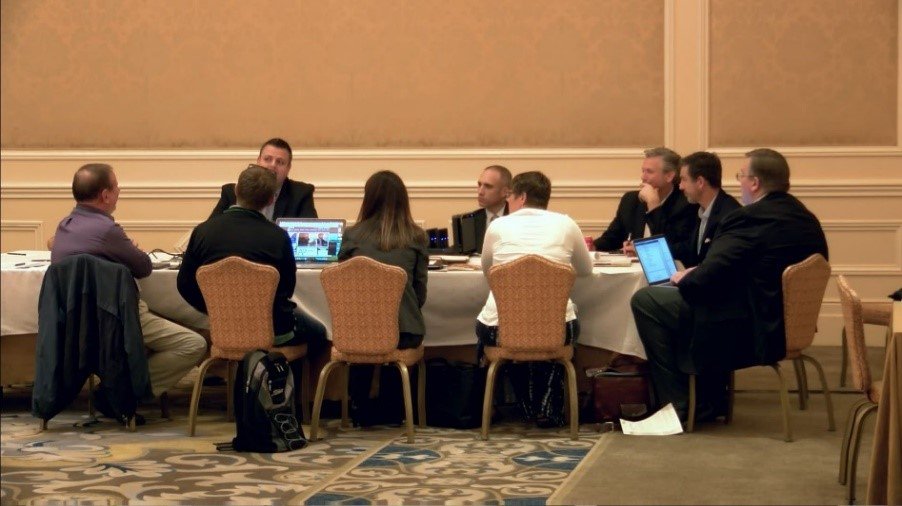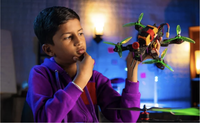The Learning Counsel met with education professionals from across the country at our annual event, The Gathering, on November 2, 2017. During this event we discussed and assessed a wide variety of topics and applications of digital curriculum. During the event smaller learning groups were formed to focus on specific topics. In one of these groups we took an in-depth look at the ins-and-outs of Re-Design.
Re-Design Learning Group
Re-Design is an essential topic to examine when implementing digital learning strategies. The subject encompasses all aspects of how to make the necessary strategic and physical adjustments to allow for the employment of new instructional methodologies. Specific topics discussed included physical environments, instructional methodologies, blended learning, personalized learning environments, professional development, hiring processes, supervision, utilization of digital resources and feedback loops. With the extensive scope of this topic the group delved into some interesting areas regarding how their institutions are implementing re-design to incorporate digital learning tools.
Hosted by Group Chairmen Ben Fobert, Principal, Lammersville Joint USD, Mountain House, California and Gisela Albuquerque-Weise, Canon Ed Tech Expert & Lead, New York, New York
Contributing members of the group include:
- Maria Lopez, Instructional Digital Design/Academic Models, New York, New York
- Bill Johnsen, Director of IT, Virginia Beach City Public Schools, Virginia Beach, Virginia
- Dwight Goodwin, Director of IT, Denton ISD, Denton, Texas
- Tori Teague, Assistant Superintendent, St. Vrain Valley Schools, Longmont, Colorado
- Robert Tidrow, Chief Operations Officer, Richmond Community Schools, Indianapolis, Indiana
- David Long, Director of Education and Technical Services, Logan City SD, Logan, Utah
- Tony Zeikle, VP of Sales, Lightspeed Technologies, Tualatin, Oregon
“What we are envisioning is a brand new high school culture, functioning by means of a brand new high-school. Tech can function as a tool, facilitator, tour-guide and curator of knowledge.” – Ben Fobert, Principal, Lammersville Joint USD
Principal Ben Fobert led the discussion on Re-Design. Ben discussed strategies and aspects of transforming spaces institutions already have and retooling them to support new learning styles. Ben advised, “To effectively plan and implement strategic changes, teachers and administrators should consider what the school day looks like in terms of its natural flow and how technologies and re-design can support and improve this natural movement.” Ben noted that, “What we are envisioning is a brand new high school culture, functioning by means of a brand new high-school. Tech can function as a tool, facilitator, tour-guide and curator of knowledge.”
One potential re-design strategy would be employing the Station-Rotation model. Station-Rotation models function by having students spend an allotted amount of time at different workstations within a class. An example of a possible station-rotation model could include: teacher-led instruction, working with an educational software, and collaborating with other students. This strategy falls in the category of Blended Learning. Blended Learning encompasses teaching strategies that incorporate digital learning as well as traditional classroom methods. Assisting in these new classroom configurations are a variety of options. One possibility would be to utilize a modular space. These spaces are often found pre-fabricated and designed specifically to allow for the employment of a blended learning strategy. Another option is simply moving furniture around in a classroom to accommodate different learning stations.
Chairperson Gisela Albuquerque-Weise shared with the group a presentation on Canon and their new developments with imaging technology. Canon has been researching how they can best leverage their imaging technologies to assist in educational settings. Gisela noted that, “On the path to sustainable digital transformation, teachers and administrators should keep in mind that strategic design is as relevant as physical design. To bridge this gap, creation of well-integrated environments with a mind for sustainability results in the successful implementation of a blended learning classroom. Great re-design, both strategic and physical, are keys to enabling an enhanced teaching and learning process”. There are a lot of options and possible routes when it comes to redesign. It is exciting to see so much creativity employed by those striving to improve their methodologies by employing new digital teaching tools.
When discussing professional development and the hiring process, Bill Johnson, Director of IT for the Virginia Beach City Public Schools (VBCPS), shared how they have successfully restructured their schools. In the VBCPS they have hired a technology specialist for each school. These specialists offer advanced skillsets giving their schools the technical expertise needed to implement digital curriculum strategies with ease. Technology specialists also are employed to offer necessary PD when utilizing new technologies. Bill noted that when launching a new digital strategy, they often conduct testing in an “anchor” school. Only after successful testing are the technologies rolled out to the rest of the schools. He also noted that the supportive involvement of their Superintendent as well as the school board have been instrumental in seeing these strategies put into action. The success of the VBCPS re-design both strategically and physically, showcase how important it is to have collaboration and cohesion between teachers, administrators and IT staff.
The discussion on re-design proved lively and informative. Teachers and administrators are taking initiative to implement effective re-design, allowing their schools to employ enhanced teaching methodologies. While there are many options and potentially successful strategies when it comes to re-design, four main points of focus come to light:
- Strategic design is as important as physical design
- Coordination between teachers, administrators and tech staff is crucial
- Employment of technology specialists dramatically assists in implementation
- Keeping sustainability in mind when envisioning implementation strategies is prudent
The discussion with the Re-Design Learning Group at The Gathering 2017 was the first, in-person conversation on this topic. Be sure to watch for conference calls on this subject in the future. To join the conversation, visit Knowstory.com and become part of designing the future!
Existing members of this Group in Knowstory include:
Nadia Williams – Cobb County School District
Ann Crosser – Arkansas DOE
Clay Stidham Jr. – Blue Ridge Unified School District
Consuelo Frausto – Riverside Unified School District
Patrick Shipway – Medford Public School
Dawn Moye – Federal Way Public Schools
Lynn Gill – El Paso ISD
Dawn Bodden – Township High School District 214
Carmella Fair – North Carolina Department of Public Instruction
Rafael Gallardo – Puget Sound Educational Service District
Peter Servidio – Roman Catholic Diocese of Portland
Shari Kauffman – Voorhees Township Public Schools
Ben Fobert – Lammersville USD
Joshua Weil – Orange County Public Schools
Scott Holcomb – Shelby County Schools
David Long – Logan City School District
April Griffin – Alachua County Public Schools
Kelly Hunkins – Amador County Unified School District
Lynne Whitley – Georgia Virtual School
Ben Orillon – French American School of Puget Sound
Peter Haapala – Warroad Public School District
Nadirshah Velasquez – Carrollton-Farmers Branch ISD
Andrea Pritchett – Rockdale County Public Schools











